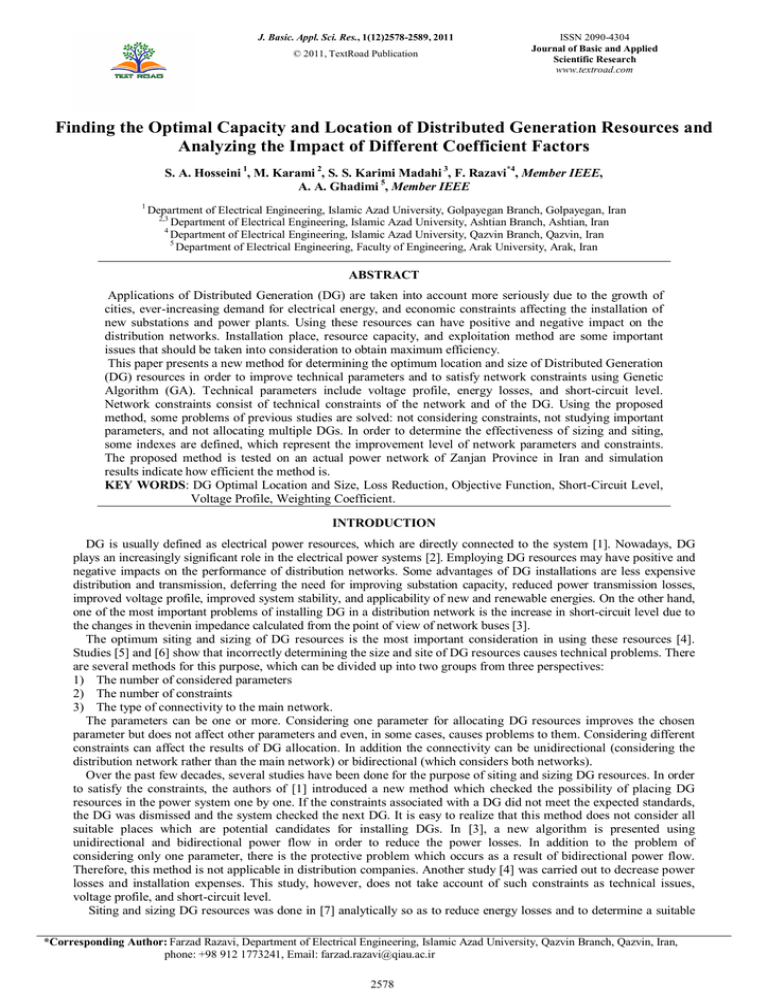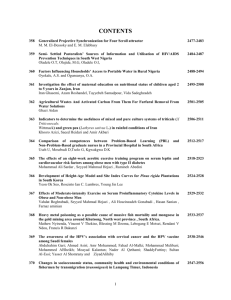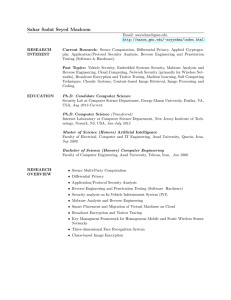Finding the Optimal Capacity and Location of
advertisement

J. Basic. Appl. Sci. Res., 1(12)2578-2589, 2011 © 2011, TextRoad Publication ISSN 2090-4304 Journal of Basic and Applied Scientific Research www.textroad.com Finding the Optimal Capacity and Location of Distributed Generation Resources and Analyzing the Impact of Different Coefficient Factors S. A. Hosseini 1, M. Karami 2, S. S. Karimi Madahi 3, F. Razavi*4, Member IEEE, A. A. Ghadimi 5, Member IEEE 1 Department of Electrical Engineering, Islamic Azad University, Golpayegan Branch, Golpayegan, Iran 2,3 Department of Electrical Engineering, Islamic Azad University, Ashtian Branch, Ashtian, Iran 4 Department of Electrical Engineering, Islamic Azad University, Qazvin Branch, Qazvin, Iran 5 Department of Electrical Engineering, Faculty of Engineering, Arak University, Arak, Iran ABSTRACT Applications of Distributed Generation (DG) are taken into account more seriously due to the growth of cities, ever-increasing demand for electrical energy, and economic constraints affecting the installation of new substations and power plants. Using these resources can have positive and negative impact on the distribution networks. Installation place, resource capacity, and exploitation method are some important issues that should be taken into consideration to obtain maximum efficiency. This paper presents a new method for determining the optimum location and size of Distributed Generation (DG) resources in order to improve technical parameters and to satisfy network constraints using Genetic Algorithm (GA). Technical parameters include voltage profile, energy losses, and short-circuit level. Network constraints consist of technical constraints of the network and of the DG. Using the proposed method, some problems of previous studies are solved: not considering constraints, not studying important parameters, and not allocating multiple DGs. In order to determine the effectiveness of sizing and siting, some indexes are defined, which represent the improvement level of network parameters and constraints. The proposed method is tested on an actual power network of Zanjan Province in Iran and simulation results indicate how efficient the method is. KEY WORDS: DG Optimal Location and Size, Loss Reduction, Objective Function, Short-Circuit Level, Voltage Profile, Weighting Coefficient. INTRODUCTION DG is usually defined as electrical power resources, which are directly connected to the system [1]. Nowadays, DG plays an increasingly significant role in the electrical power systems [2]. Employing DG resources may have positive and negative impacts on the performance of distribution networks. Some advantages of DG installations are less expensive distribution and transmission, deferring the need for improving substation capacity, reduced power transmission losses, improved voltage profile, improved system stability, and applicability of new and renewable energies. On the other hand, one of the most important problems of installing DG in a distribution network is the increase in short-circuit level due to the changes in thevenin impedance calculated from the point of view of network buses [3]. The optimum siting and sizing of DG resources is the most important consideration in using these resources [4]. Studies [5] and [6] show that incorrectly determining the size and site of DG resources causes technical problems. There are several methods for this purpose, which can be divided up into two groups from three perspectives: 1) The number of considered parameters 2) The number of constraints 3) The type of connectivity to the main network. The parameters can be one or more. Considering one parameter for allocating DG resources improves the chosen parameter but does not affect other parameters and even, in some cases, causes problems to them. Considering different constraints can affect the results of DG allocation. In addition the connectivity can be unidirectional (considering the distribution network rather than the main network) or bidirectional (which considers both networks). Over the past few decades, several studies have been done for the purpose of siting and sizing DG resources. In order to satisfy the constraints, the authors of [1] introduced a new method which checked the possibility of placing DG resources in the power system one by one. If the constraints associated with a DG did not meet the expected standards, the DG was dismissed and the system checked the next DG. It is easy to realize that this method does not consider all suitable places which are potential candidates for installing DGs. In [3], a new algorithm is presented using unidirectional and bidirectional power flow in order to reduce the power losses. In addition to the problem of considering only one parameter, there is the protective problem which occurs as a result of bidirectional power flow. Therefore, this method is not applicable in distribution companies. Another study [4] was carried out to decrease power losses and installation expenses. This study, however, does not take account of such constraints as technical issues, voltage profile, and short-circuit level. Siting and sizing DG resources was done in [7] analytically so as to reduce energy losses and to determine a suitable *Corresponding Author: Farzad Razavi, Department of Electrical Engineering, Islamic Azad University, Qazvin Branch, Qazvin, Iran, phone: +98 912 1773241, Email: farzad.razavi@qiau.ac.ir 2578









